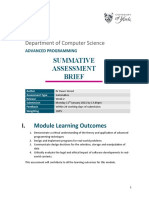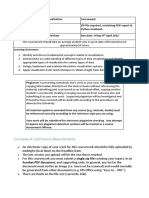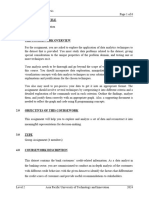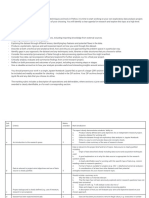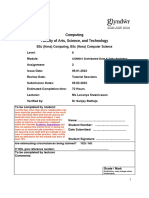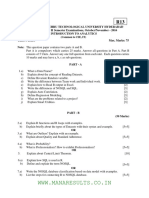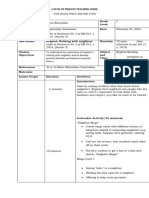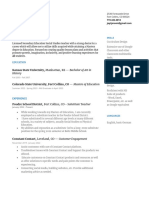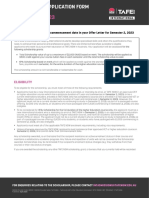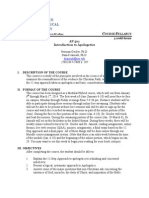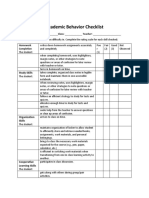CS5801 PG Assessment Brief 2024-25
Uploaded by
mea.uk145CS5801 PG Assessment Brief 2024-25
Uploaded by
mea.uk145Department of Computer Science
CS5801 Quantitative Data Analysis
Assessment/Coursework for 2024/25
TABLE OF CONTENTS
Main Objective of the Assessment................................................................................................................... 1
Description of the Assessment ......................................................................................................................... 1
Learning Outcomes and Marking Criteria ....................................................................................................... 2
Submission Instructions ..................................................................................................................................... 5
Avoiding Academic Misconduct ........................................................................................................................ 5
Expectations of Artificial intelligence Use ....................................................................................................... 6
Late Coursework................................................................................................................................................. 6
Appendix – Metadata ......................................................................................................................................... 7
Assessment Title Quantitative Data Analysis
Module Leader Dr Isabel Sassoon, Prof Martin Shepperd
Distribution Date 30/10/2024
Submission Deadline 6th of January 2025 11.00 am UK time
Feedback by 27/02/2025
Contribution to overall module assessment 100 %
Indicative student time working on assessment 70 Hours
Word or Page Limit (if applicable) 2000 Words (not including code and references)
Assessment Type (individual or group) Individual Coursework
MAIN OBJECTIVE OF THE ASSESSMENT
The coursework is based on undertaking an authentic analysis of a real-world data set. It is a shared assessment
block for CS5701 Quantitative Data Analysis and CS5702 Modern Data.
This assessment offers an opportunity to bring together your skills from CS5701 (Quantitative Data Analysis)
and CS5702 (Modern Data). Note that for students on MSc Data Science and Analytics and MSc. Artificial
Intelligence there is also a second shared assessment block CS5802 which takes the form of a written closed
book examination.
DESCRIPTION OF THE ASSESSMENT
In order to work on the assessment, you will be provided with:
(i) A data set (student_data.Rda)
(ii) The data set metadata is provided at the end of this assessment brief, (note students will
generate a subset of the dataset by following the instructions provided in the proforma Rmd
and explained below)
(iii) An submission R markdown proforma with questions to guide your analysis (proforma-
submission-24-25.Rmd). This submission rmd file is the only file that will be used for marking,
(iv) A supporting R markdown proforma to use to contain additional material (proforma-
supporting-24-25.Rmd). This file will also need to be submitted.
In order to submit the assessment you will need to submit two files:
(i) A proforma-submission-24-25.Rmd file. This is the only file that will be used for marking and needs
to be clearly named (see submission instructions on page 5 for details)
(ii) A proforma-supporting-24-25.Rmd file. This file will also need to be submitted. (see submission
instructions on page 5 for details)
In order to answer the questions in the submission R markdown you will need to explore different options so
use the supporting R markdown document to contain additional parts of the exploration code and outputs. For
Updated August 2023 1 of 7
Department of Computer Science
example: you may do a more comprehensive EDA in order to decide which three elements you find most
informative.
Generating your personal data sets
1. Each student should use a subset from the overall dataset student_data.Rda which can be
downloaded from the Brightspace page for CS5801.
2. The subset of the data that you will work on depends on your student id.
3. At the top of the proforma-submission-24-25.Rmd file provided (can be downloaded from the
Brightspace page of CS5801) there are instructions on how to use your student id to obtain the
subset of data you need to work on. The same should be done in proforma-supporting-24-
25.Rmd.
4. The code for sub setting is embedded in the RMarkdown template. You only need to configure it
for your student id.
5. If you are uncertain, please check!
General Guidance:
1. You are expected to use R in a RMarkdown file for your analysis.
2. Use the proforma-supporting-24-25.Rmd and the questions to work on your full analysis then
for submission purposes you need to complete all the sections in the proforma-submission-24-
25.Rmd.
3. Update the YAML to include your name and other identifier information.
4. Follow the principles of ‘literate programming’ so choose meaningful variable and function
names and add comments.
5. You need to submit the supporting file but the marking will be done on the contents of
proforma-submission-24-25.Rmd. Make sure that if you claim to have tried an approach in the
submission file then the relevant code is in the proforma-supporting-24-25.Rmd.
6. Where appropriate cite external sources and add a bibliography at the end of your main report.
7. The .Rmd file should be professionally presented with good structure, an absence of spelling
errors and other typos and written in an appropriate style (i.e., simple to the point, unemotive
language).
8. Make sure you respect the 2000 word limit as well as the specific section word limits as we
discourage excessive padding, so unnecessary words and waffle will militate against professional
presentation. This word count does not include contents of code chunks or references.
9. Where answers to sections contain more words than those in the word limit for that section (See
the marking criteria below) then words beyond the maximum word count (with a discretionary
20% buffer) will be disregarded and will mean you lose marks.
10. Avoid including generic definitions and focus on contextualising your explanations and findings
from your analysis of your specific data set subset.
11. Sometimes even suitable models do not have good fit due to the nature of the data. In such
circumstances you will not be penalised.
12. Whilst we encourage collaboration and sharing of ideas this is an individual report and so must
be based on your own understanding, analysis and words. WiseFlow automatically cross-
compares all submissions.
13. WiseFlow also has a plagiarism detector for external sources. We encourage you to use such
sources including R packages, code, ideas for data analysis and other statistical sources, but you
must acknowledge the sources. In other words, do not attempt to pass off the work of others as
your own.
14. If you have questions, please post a question on the Brightspace CS5801 Discussion Forum or ask
one of us. Don’t guess!
LEARNING OUTCOMES AND MARKING CRITERIA
LO1: Design and implement methods and protocols for data preparation and exploration using advanced
statistical techniques.
LO2: Apply these methods on real data to generate novel insight, critically evaluate its value and design a
framework for data management and sharing.
Updated August 2023 2 of 7
Department of Computer Science
Below we give the details of the marking scheme.
(Note: the mark scheme below is applied to contents the submission Rmd file. This submission rmd file is the
only file that will be used for marking)
section question question Guidance Marks word Mapping
no. count to LO
0 Presentation, Your submission Rmd file should 10 LO2
clarity and good be clearly and professionally
practice for the presented with appropriate use of
report cited external sources You report
should respect the word counts in
each section and a supporting
proforma.rmd should also be
submitted. The report should not
include generic definitions or
statements that are not linked to
your analysis
0 Programming The code needs to run end to end 10 LO1
in both the submission Rmd (this
one) and the supporting one. It
should also be easy to understand,
with well-documented code
following the principles of literate
programming. The code
documentation needs to be
specific to your analysis (The
supporting rmd document also
needs to be submitted)
1 Organise and
clean the data
1.1 Subset the data Use R code to correctly select the 5 LO1
into the specific subset of data allocated.
dataset allocated
1.2 Data quality plan Provide a description of the steps 5 200 LO2
you took to assess the quality of
this data. Include and refer to all
variables/columns from the data
set.
1.3 Data quality List three data quality issues you 9 300 LO1
findings have identified. For each one
include the code that supports the
finding in the code chunks
provided.
1.4 Data Cleaning For the three issues listed in 1.3 6 200 LO1
explain how you addressed each of
the issues. Include justification for
each of the approaches to address
the issue, alternative approaches
considered and supply the code
within the code chunks provided
2 EDA
Updated August 2023 3 of 7
Department of Computer Science
2.1 EDA Summary In this section include: 15 300 LO2
(i) A brief explanation of your
approach to exploring the data set
also with respect to the dependent
variables.
(ii) three elements (graphical or
numerical/textual/tabular) of your
exploratory analysis that you find
are most informative. Include the
code for each one (in the separate
chunks provided) and explain and
interpret the output and also
articulate why this is informative
and helpful. (You should provide
the code for you exploration in the
supporting proforma.)
3 Modelling
dependent
variable 1
3.1 Explain your The aim of the analysis is to model 10 400 LO1
analysis the variable Grade Point Average
(variable name:
grade_point_average). Describe
and justify the steps you took to
model this variable (don't include
or repeat the data cleaning and
EDA plan). Explain:
What methods you used and why?
How were the findings from EDA
incorporated?
What model selection approach
did you take?
How did you address weaknesses
in models?
What alternative approaches did
you consider?
You should be specific to your data
set in your justifications
Do not include or repeat the data
cleaning and EDA plan
Do not include code for all the
models you considered (this
should be in the supporting
proforma)
3.2 Provide a model Explain, interpret and justify from 10 100 LO2
for grade point all the models attempted the
average model you think is best.
Include the code for that model in
a code chunks alongside any code
related to diagnostics.
4 Modelling
dependent
variable 2
Updated August 2023 4 of 7
Department of Computer Science
4.1 Model the Model the likelihood of 10 400 LO1
likelihood of completing an extended project
completing an (using the
extended project completed.extended.project
variable provided)
The aim of the analysis is to model
whether a student has completed
an extended project or not. (i.e.,
involving the binary target
attribute).
*Describe and justify the steps you
took to model whether a student
completed an extended project or
not (don't include or repeat the
data cleaning and EDA plan or
don’t include the code for all the
models attempted).
Do explain:
What methods you used and why?
How were the findings from EDA
incorporated?
What model selection approach
did you take?
How did you address weaknesses
in models?
What alternative approaches did
you consider?
4.2 Propose one Justify and propose one model. 10 100 LO2
model Describe, interpret and critique it.
Include the code for this proposed
model in a code chunk provided
SUBMISSION INSTRUCTIONS
You must submit your coursework as two .rmd files on WISEflow by 06/01/2025 at 11am. You can follow the
link to WISEflow through the module’s section on Brightspace or login in directly at
https://uk.wiseflow.net/brunel. The name of your files should follow the normal convention and must
therefore include your student ID number and indicate whether it is submission or supporting file (e.g.,
0612345-submission-24-25.Rmd and 0612345-supporting-24-25.Rmd). It can also include the module code
(e.g., CS5801_0612345-submission-24-25.rmd and CS5801_0612345-supporting-24-25.rmd).
AVOIDING ACADEMIC MISCONDUCT
Before working on and then submitting your coursework, please ensure that you understand the meaning
of plagiarism, collusion, and cheating (including contract cheating) and the seriousness of these offences.
Academic misconduct is serious and being found guilty of it results in penalties that can reduce the class of
your degree and may lead to you being expelled from the University. Information on what constitutes
academic misconduct and the potential consequences for students can be found in Senate Regulation 6.
You may also find it useful to read this PowerPoint presentation which explains, in plain English, the different
kinds of misconduct, how to avoid (even accidently) committing them, how we detect misconduct, and the
common reasons that students give for engaging in such activities.
If you are experiencing difficulties with any part of your studies, remember there is always help available:
Updated August 2023 5 of 7
Department of Computer Science
• Speak to your personal tutor. If you’re not sure who your tutor is, please ask the Taught
Programmes Office (TPOcomputerscience@brunel.ac.uk).
• Alternatively, if you prefer to speak to someone outside of the Department you can contact
the Student Support and Welfare team.
EXPECTATIONS OF ARTIFICIAL INTELLIGENCE USE
The University has general guidance on using artificial intelligence in your studies.
Generative AI (GenAI) and Large language models (LLMs) such as chatGPT and Claude all have the potential to
answer questions on code and material relevant to this assessment. Using AI-generated content and presenting
it as your original work in this assessment is strictly prohibited. Despite its many useful services, such as,
information search and retrieval, concept explanations and proofreading, it is crucial to recognize its inherent
limitations. For instance, responses generated by AI can be overly general, inaccurate, biased, or even
fabricated. They often lack proper references and detailed insights and may pose challenges in terms of
intellectual property rights and data privacy.
If you make use of Generative AI tools in any part of this assessment, it is essential to:
• Acknowledge that you have used GenAI, how you used it and reference any of the AI contents used in
your submission (including code). If you need to reference or cite content from an AI tool, use the
name of the tool used (e.g. Claude).
• Avoid copying explanations, text, or code directly from a GenAI tool into your assessment submission.
Use your own words to answer the questions asked in the assessment. If you use GenAI , to help with
code rigorously test and alter the code to fulfill the requirements of the assessment, also comment
the code in your own words.
• Understand any code you submit or explanation you provide and be ready to explain it verbally. In the
event of any concerns regarding the integrity of your work, an oral examination may be scheduled for
further evaluation.
Misuse of Generative AI can lead to academic misconduct for more details see the link to the general
guidance from the University above.
LATE COURSEWORK
The clear expectation is that you will submit your coursework by the submission deadline stated in the study
guide. In line with the University’s policy on the late submission of coursework (revised in July 2016),
coursework submitted up to 48 hours late will be accepted but capped at a threshold pass (D- for
undergraduate or C- for postgraduate). Work submitted over 48 hours after the stated deadline will
automatically be given a fail grade (F).
Please refer to the Computer Science student information pages and the Coursework Submission Procedure
pages for information on submitting late work, penalties applied and procedures in the case of Extenuating
circumstances.
Updated August 2023 6 of 7
Department of Computer Science
APPENDIX – METADATA
This data set includes data related to one large cohort of secondary school students from different schools.
Variable Name Description
student_id Student ID
entry_exam_mark Students entering the school have taken an exam.
Marks are between 0 and 100.
sat_score Students have taken the SAT test that is graded
between 0 and 1600.
percentage_absence Student’s absence is computed as a percentage
free_school_meals This column is Yes if the student is entitled to
financial support covering the cost of their school
lunch. No otherwise.
grade_point_average This is the grade students achieved at graduation
completed.extended.project This is Yes when students completed an
independent project during the school year. No
Otherwise.
month_of_birth Month of Birth of students
commute_method This shows the method of travel to and from school
for each student. (Bicycle, Bus, Car, Walking, Other)
Updated August 2023 7 of 7
You might also like
- Assignment 1 Specification - T1 - 2023 - COIT12209No ratings yetAssignment 1 Specification - T1 - 2023 - COIT122093 pages
- Assessment Brief Template 2024-2025 - CS3003 - Copy (1) 8No ratings yetAssessment Brief Template 2024-2025 - CS3003 - Copy (1) 83 pages
- Assignment 2 Specification SWE5204 Advanced Databases and Big DataNo ratings yetAssignment 2 Specification SWE5204 Advanced Databases and Big Data8 pages
- CS5812 Predictive Data Analysis: Coursework For 2022/23No ratings yetCS5812 Predictive Data Analysis: Coursework For 2022/233 pages
- R-Programming 2023 Special Supplementary AssignmentNo ratings yetR-Programming 2023 Special Supplementary Assignment2 pages
- COM7036M BigData Assessment Brief2023-2024No ratings yetCOM7036M BigData Assessment Brief2023-20248 pages
- Principle of Datascience - Assignment Specification - MayNo ratings yetPrinciple of Datascience - Assignment Specification - May7 pages
- Capstone Project - Foundations of Data Science0% (1)Capstone Project - Foundations of Data Science6 pages
- WWW - Manaresults.Co - In: (Common To CSE, IT)No ratings yetWWW - Manaresults.Co - In: (Common To CSE, IT)2 pages
- CC4057NI - Introduction To Information Systems S21 (1st Sit) - CW2 QPNo ratings yetCC4057NI - Introduction To Information Systems S21 (1st Sit) - CW2 QP5 pages
- Assignment 1 - Introduction To Data ScienceNo ratings yetAssignment 1 - Introduction To Data Science3 pages
- 7 R Programming Computer Science and Applications CCSANo ratings yet7 R Programming Computer Science and Applications CCSA2 pages
- School of IT & Business Technologies Graduate Diploma in Data Analytics (Level 7)No ratings yetSchool of IT & Business Technologies Graduate Diploma in Data Analytics (Level 7)10 pages
- Data Analytics With R - BDS306C - LAB - FullNo ratings yetData Analytics With R - BDS306C - LAB - Full61 pages
- Chapter 1: Introduction To Assessment in Learning Lesson 2: The Roles of Assessment in The Intructiontional Decision EvaluationNo ratings yetChapter 1: Introduction To Assessment in Learning Lesson 2: The Roles of Assessment in The Intructiontional Decision Evaluation3 pages
- Practical AFL Strategies in Class Room-Academic Year-2016/17No ratings yetPractical AFL Strategies in Class Room-Academic Year-2016/172 pages
- TAFE NSW International Scholarship Application Form S2 2023No ratings yetTAFE NSW International Scholarship Application Form S2 20235 pages
- TL101-0-2025-Fully-Online - BEng Tech Honours - SEBE - STR4801No ratings yetTL101-0-2025-Fully-Online - BEng Tech Honours - SEBE - STR480124 pages
- Usmc Intelligence Training and Readiness Manual100% (1)Usmc Intelligence Training and Readiness Manual1,055 pages
- Calendar of Activities 2017-2018 - Institutional CalendarNo ratings yetCalendar of Activities 2017-2018 - Institutional Calendar8 pages



